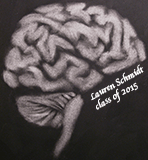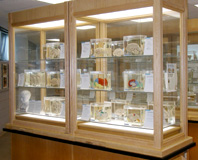GLOSSARY
AFFERENT - travelling into an area of the central nervous system from another area; usually refers to sensory nerve fibers travelling into the CNS, but this term can be used more generally to refer to any group of fibers travelling to a location.
ALS - 1) anterolateral system; also known as spinal lemniscus. Several closely related tracts (spinothalamic, spinoreticular, spinotectal) in the pain and temperature system that travel adjacent to each other through the spinal cord and brainstem. 2) Also the abbreviation for Amyotrophic Lateral Sclerosis (Lou Gherig´s Disease), which is a neurodegenerative disease affecting upper and lower motoneurons.
AMYGDALA - a group of nerve cell bodies within the cerebral hemipheres near the temporal pole; (from Latin - almond shaped).
BASILAR PONS - the large, bulging part of the pons ventral to the medial lemniscus.
BASIS PEDUNCULI - a wide band of fibers on the ventral surface of the midbrain. It contains the corticospinal, corticobulbar and cerebrocerebellar fibers. It is also known as crus cerebri.
BRAINSTEM - the part of the brain between the spinal cord and the diencephalon. It is composed of the medulla, pons, and midbrain.
COLLICULUS - a small elevation on the surface of the brainstem, e.g. the superior colliculus and inferior colliculus in the midbrain and the facial colliculus on the floor of the fourth ventricle in the pons; (from Latin - diminutive of collis meaning hill).
COMMISSURE - a group of nerve fibers that travel from one side of the CNS to the other; (from Latin - to join together).
CONTRALATERAL - on the opposite side of the nervous system; oppposite of ipsilateral.
CORONA RADIATA - fibers traveling to and from the cerebral cortex fan out to form a "radiating crown" as they travel through the deeper parts of the cerebral hemispheres. This is a continuation of the internal capsule.
DECUSSATION - a cross-over at the midline of the brainstem; the location where axons cross from one side of the CNS to the other.
EFFERENT - travelling away from an area of the central nervous system; usually refers to motor nerve fibers travelling out of the CNS, but this term can be used more generally to refer to any group of fibers travelling away from a location.
ENTORHINAL - the anterior part of the parahippocampal gyrus adjacent to the uncus. It is part of the lateral olfactory area.
EPITHALAMUS - a division of the diencephalon that contains the pineal gland and the habenular nucleus; (epi = upon).
FASCICULUS - a bundle of axons traveling through the CNS. They usually are part of a single functional system. This term has the same meaning as "tract".
FISSURE - a deep space or groove in the CNS. This term is often used interchangeably with "sulcus".
FUNICULUS - a general area of the spinal cord composed of longitudinally-oriented fibers. For example, dorsal funiculus is the area between both dorsal horns; (from Latin - funis meaning cord).
GANGLION - a group of nerve cell bodies outside the CNS; for example, dorsal root ganglion; (from Greek - ganggleon meaning swelling or knot).
GREY MATTER - the general area in the CNS containing nerve cell bodies; so-called due to the dark appearance of this area in unstained sections.
HABENULA - a nucleus of the epithalamus that is located at the dorsal posterior edge of the thalamus near the pineal gland.
HIPPOCAMPUS - a cortical area that is buried in the temporal lobe. It lies in the inferior horn of the lateral ventricle. It is involved in consolidation of episodic memory and spatial orientation.
HORNER´s SYNDROME - the loss of sympathetic innervation to the area around the eye. It is caused by the interruption of the sympathetic pathway anywhere along the brainstem, spinal cord, or postganglionic sympathetic axon. It results in a constricted pupil (meiosis), drooping of the eyelid (ptosis), dryness of the skin around the eye, and retraction of eyeball into the socket (enophthalmos).
INTERNAL CAPSULE - a general highway for axons traveling from the region of the thalamus to the cerebral cortex or the reverse. It is bounded by the thalamus, lentiform nucleus, and caudate nucleus. Dorsal to this area, this highway is given the name of corona radiata.
INTERNEURON - a general name for a neuron interposed synaptically between two other neurons; i.e. one neuron synapses onto an interneuron that, in turn, synapses onto a third neuron.
IPSILATERAL - on the same side of the nervous system; opposite of contralateral; (from Latin - ipsi meaning self).
LEMNISCUS - several tracts of related function traveling together in the spinal cord or brainstem; usually the axons of second order neurons in a sensory pathway terminating in the thalamus; for example, medial lemniscus, spinal lemniscus, trigeminal lemniscus, and lateral lemniscus.
LESION - an area of localized dysfunction in the nervous system. Interruption of tracts or nuclei in the involved area will result in decrease or complete loss of function for the pathway.
LOWER MOTONEURON - a neuron in the motor system that has a cell body in the central nervous system and an axon that enters the peripheral nervous system and synapses on a muscle.
NEUROPIL - an area containing dendrites and axon terminals where synaptic connections are made; for example grey matter, CNS nuclei.
NUCLEUS - a group of nerve cell bodies in the CNS that forms a structural and functional unit; (from Latin - nukleus meaning little nut).
PEDUNCLE - a large group of fibers connecting the brainstem with the cerebellum (inferior, middle, superior). Also, the general region ventral to the superior and inferior colliculi in the midbrain. The word peduncle (Latin - foot) implies a foot or pedestal upon which a larger structure rests, such as cerebellum or cerebral hemisphere.
POLE - in the cerebral hemispheres, the extreme end of a lobe, such as the frontal pole, occipital pole, or temporal pole.
PYRAMIDAL DECUSSATION - refers to the crossing (decussation) of the corticospinal tract of the motor system. This is a landmark for the border between the spinal cord and brainstem. The crossing occurs at the caudal end of the caudal medulla on the ventral surface. Occasionally, the crossing fibers are visible on a gross specimen.
PYRIFORM AREA - Part of the olfactory cortex containing the uncus and entorhinal area; (Latin - pear shaped).
RETICULAR FORMATION - A large area that extends throughout all brainstem levels. It forms the core of the brainstem, generally the more dorsal region, in which loosely associated axons and scattered cell bodies comprise most of the inconspicuous areas where tracts and nuclei are not well defined; (from Latin - diminutive of rete meaning net).
ROOT - (as in nerve root) the name given to nerve fibers at their point of entrance or exit from the CNS (brainstem, spinal cord, etc). Rootlet indicates a small root, especially as a major nerve trunk divides into smaller branches, for example on entering the spinal cord.
SEPTA - a separation in the spinal cord formed by invagination of the pia membrane. Also, a thin wall dividing two cavities or masses of softer tissue; (from Latin - saeptum meaning partition).
SEPTUM PELLUCIDUM - a thin membrane that covers the body of the lateral ventricles on the medial surface of each cerebral hemisphere.
SULCUS - a groove or depression in the surface of the brainstem, cerebral hemispheres, or spinal cord. This term is used interchangeably with "fissure".
TECTUM - literally, the roof of the midbrain. Tectum refers to the superior and inferior colliculi; (from Latin - tego meaning to cover).
TEGMENTUM - generally, the more dorsal areas of the brainstem. For example, in the pons it is the area from the medial lemniscus to the dorsal surface of the pons.
TRACT - a bundle of axons travelling through the CNS as part of a single functional system. The term is similar to fasciculus.
TRAPEZOID BODY - transversely-oriented auditory fibers located at the junction between the dorsal and ventral portions of the caudal pons. These fibers pass across the fibers of the medial lemniscus.
TRIGEMINAL LEMNISCUS - the axons of second order neurons of the trigeminal system carrying touch, pain, and temperature information to the thalamus. It is also known as the ventral central trigeminothalamic tract.
TUBERCULUM - a bump or ridge on the surface of the brainstem caused by an underlying nucleus or nerve tract. For example, the tuberculum gracilis is the bump formed by nucleus gracilis; (from Latin - diminutive of tuber meaning swelling or tumor).
UPPER MOTONEURON - a neuron in the motor system that has a cell body in the central nervous system and whose axon remains within the central nervous system. It synapses on a lower motoneuron either directly or via an interneuron.
VELUM - a thin membrane that forms part of the roof of the fourth ventricle at its rostral end (superior medullary velum) and caudal end (inferior medullary velum); from Latin - veil meaning sail.
VENTRAL CENTRAL TRIGEMINOTHALAMIC TRACT - aka VCTT, trigeminothalamic tract or trigeminal lemniscus; these are second order axons in the trigeminal pathway. They originate in the Spinal Nucleus of V and the Principle Sensory Nucleus of V, travel in the dorsal part of the medial lemniscus, and terminate in the Ventral Posterior Medial nucleus of thalamus.
VERMIS - in the cerebellum, the narrow, central strip of cortex between the two hemispheres; (from Latin - verminosis meaning wormy).
WHITE MATTER - the area in the CNS where axons are located; so-called due to the white appearance of myelin in unstained tissue.





